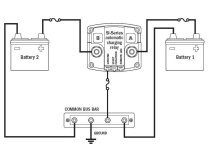- Joined
- Dec 18, 2003
- Messages
- 5,045
I PM'd RRRAAAYYY2 with this question, but figured we could all benefit from knowing the answer.
I've been looking at dual battery systems for my boat and found a basic principle using an automatic charging relay(ACR).
http://bluesea.com/category/2/productline/overview/387
I've devised what the circuit should look like, but am curious what the current is between the batteries when the relay switches from isolated to parallel, particularly when one battery is already drained.

best I can tell, this is close to how the painless dual battery setup is designed.
I've been looking at dual battery systems for my boat and found a basic principle using an automatic charging relay(ACR).
http://bluesea.com/category/2/productline/overview/387
I've devised what the circuit should look like, but am curious what the current is between the batteries when the relay switches from isolated to parallel, particularly when one battery is already drained.

best I can tell, this is close to how the painless dual battery setup is designed.













